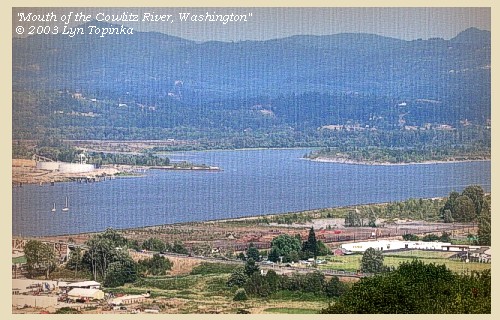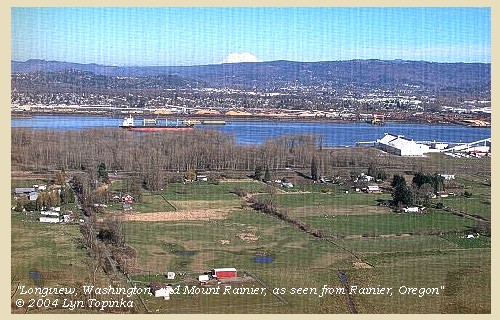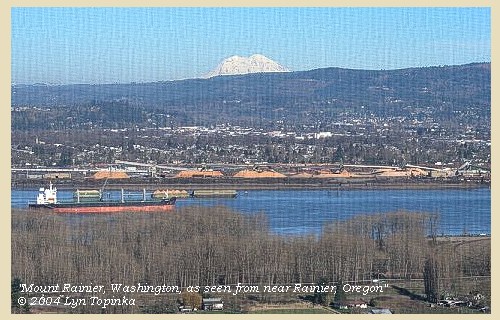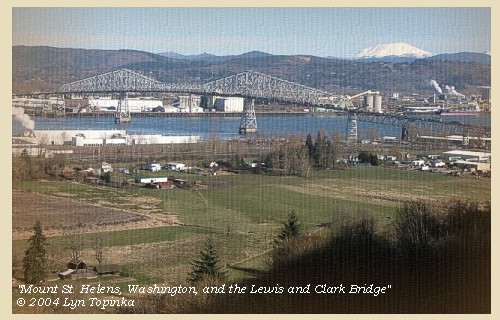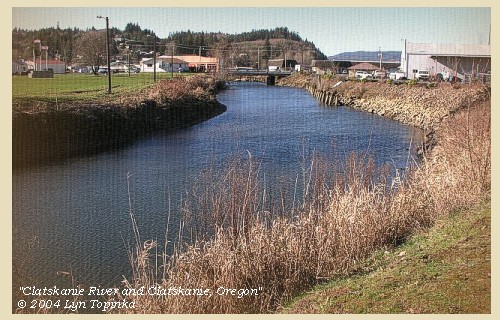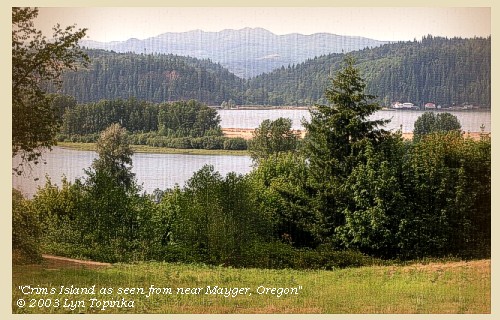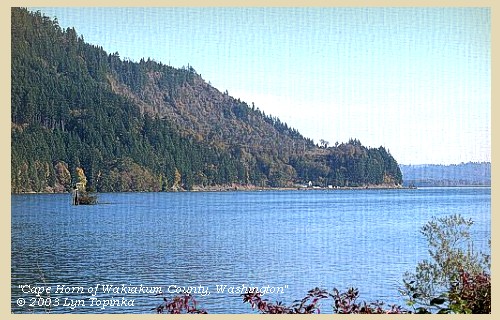The Volcanoes of
Lewis and Clark
Lewis and Clark
|
November 6, 1805 Heading to the Pacific - Prescott Beach to Wallace Island |
|
Home
The Volcanoes of Lewis and Clark Map of the Journey Volcanoes, Basalt Plateaus, Major Rivers, etc. The Volcanoes Mount Adams, Mount Hood, Mount Jefferson, Mount Rainier, and Mount St. Helens CALENDAR of the Journey October 1805 to June 1806 Along the Journey Pacific Northwest Maps - Columbia River, Volcanoes, Flood Basalts, Missoula Floods, Geology, etc. The Corps of Discovery The Journey of Lewis and Clark About the Reference Materials The Journals, Biddle/Allen, DeVoto, Gass, Moulton, Topo Maps, and others USGS Lewis and Clark Links Links to USGS Websites highlighting the Lewis and Clark Journey Resources Publications Referenced and Websites Visited |
PREVIOUS
November 5 Ridgefield NWR to Prescott Beach, Oregon |
November 6
Heading to the Pacific, Prescott Beach to Wallace Island Prescott Beach, Cottonwood Island, Cowlitz River, Longview (Washington) and Rainier (Oregon), Lewis and Clark Bridge, Mount Rainier and Mount St. Helens, Mount Coffin, Clatskanie River, Crims Island, Eagle Cliff and Cape Horn |
CONTINUE
November 7 Nearing the Pacific, Wallace Island to Pillar Rock |
|
To the Pacific - November 1805
Heading to the Pacific - Prescott Beach to Wallace Island |
| Lewis and Clark's campsite of November 5, 1805, was "under a point of high ground, with thick pine trees", near the location of today's Prescott Beach County Park, Oregon. |
| Wednesday, November 6, 1805 |
| The morning was cool, wet, and rainy. We proceeded at an early hour between the high hills on both sides of the river, till at the distance of four miles we came to two tents of Indians in a small plain on the left, where the hills on the right recede a few miles from the river, and a long narrow island [Cottonwood Island] stretches along the right shore. |
|
|
|
Cottonwood Island:
Today, Carrolls Channel, between Cottonwood Island and the Washington shore of the Columbia River, is used for log storage and fishing boats. About 13 feet can be carried through the channel. -- NOAA Office of Coast Survey Website, 2003 |
| Behind this island [Cottonwood Island] is the mouth of a large river a hundred and fifty yards wide, and called by the Indians, Coweliske [Cowlitz River]. |
| We halted for dinner on the island [Cottonwood Island], but the red wood and green briars are so interwoven with the pine, alder, ash, a species of beech, and other trees, that the woods form a thicket, which our hunters could not penetrate. |
| Lewis and Clark are passing areas where today are located the cities of Longview, Washington (on the right bank) and Rainier, Oregon (on the left bank). Connecting the two cities is the Lewis and Clark Bridge. Had the day been clear, Mount Rainier and Mount St. Helens would have been visible from the Oregon side of the Columbia River. |
| On a clear day Mount Rainier and Mount St. Helens are visible from the Oregon side of the Columbia River. |
| Below the mouth of the Coweliske [Cowlitz River] a very remarkable knob [Mount Coffin] rises from the water's edge to the height of eighty feet, being two hundred paces round the base; and as it is in a low part of the island, and some distance from the high grounds, the appearance of it is very singular. |
| "... pasd. a remarkable Knob of high land on the Stard. Side at 3 miles ..." [Clark, November 6, 1805, first draft] |
| "... I had like to have forgotten a verry remarkable Knob riseing from the edge of the water to about 80 feet high, and about 200 paces around at its Base and Situated on the long narrow Island above and nearly opposit to the 2 Lodges we passed to day, it is some distance from the high land & in a low part of the Island ..." [Clark, November 6, 1805] |
| On setting out after dinner ...... Nine miles below that river [Cowlitz River] is a creek on the same [Coal Creek, Note: this Biddle/Allen quotation says 9 miles apart, Thwaites and Moulton editions say 6 miles, and Clark's Journey Log says nothing]; and between them three smaller islands; one on the left shore, the other about the middle of the river; and a third near the lower end of the long narrow island [Cottonwood Island], and opposite a high cliff of black rocks on the left, sixteen miles from our camp. ...... |
| "... A cool wet raney morning we Set out early at 4 miles passed 2 Lodges of Indians in a Small bottom on the Lard Side I believe those Indians to be travelers. opposit is the head of a long narrow Island close under the Starboard Side, back of this Island two Creeks fall in about 6 miles apart, and appear to head in the high hilley countrey to the N. E. opposit this long Island is 2 others one Small and about the middle of the river the other larger and nearly opposit its lower point, and opposit a high clift of Black rocks on the Lard. Side at 14 miles ..." [Clark, November 6, 1805] |
| At these cliffs the mountains, which had continued high and rugged on the left, retired from the river, and as the hills on the other side had left the water at the Coweliske, [Cowlitz River], a beautiful extensive plain now presented itself before us: [beginning of the flood plain of the Clatskanie River. On their map, Lewis and Clark call this "Fannys Valley"] |
| for a few miles we passed along side of an island a mile in width and three miles long [Crims Island. Lewis and Clark later name this island "Fannys Island"], below which is a smaller island, where the high rugged hills, thickly covered with timber, border the right bank of the river, and terminate the low grounds: these were supplied with common rushes, grass, and nettles; in the moister parts with bullrushes and flags, and along the water's edge some willows. ...... |
| After crossing the plain and making five miles, we proceeded through the hills for eight miles. The river is about a mile in width, and the hills so steep [vicinity of Eagle Cliff, Washington side] that we could not for several miles find a place sufficiently level to sufer us to sleep in a level position: at length, by removing the large stones, we cleared a place fit for our purpose above the reach of the tide, and after a journey of twenty-nine miles slept among the smaller stones under a mountain to the right [Washington side between Eagle Cliff and Cape Horn, across from Wallace Island]. |
| The weather was rainy during the whole day; we therefore made large fires to dry our bedding and to kill the fleas, who have accumulated upon us at every old village we have passed. |
|
|
|
The Camp - November 6, 1805:
On the Washington side of the Columbia River, between Eagle Cliff and Cape Horn, across from Wallace Island. |
| Home | Previous | Continue |
If you have questions or comments please contact: GS-CVO-WEB@usgs.gov
June/July 2004, Lyn Topinka
The Volcanoes of Lewis and Clark Home Page | CVO Home Page


